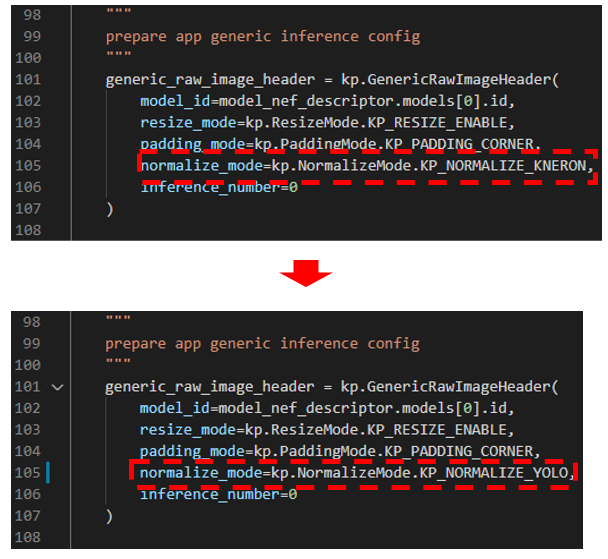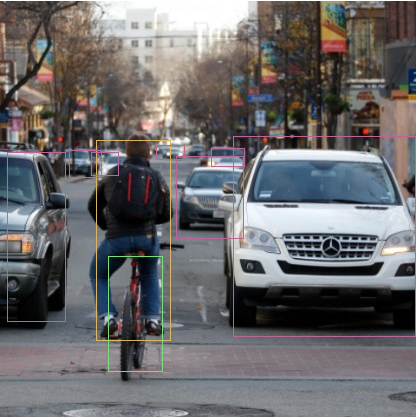YOLOv3 Step by Step
In this document, we provide a step by step example on how to utilize our tools to compile and test with a newly downloaded YOLOv3 model.
This document is writen for toolchain v0.22.0. If any description is not consistent with the latest toolchain, please refer to the main toolchain manual.
Step 0: Prepare environment and data
We need to download the latest toolchain docker image which contains all the tools we need.
docker pull kneron/toolchain:latestStart the docker with a local folder mounted into the docker.
docker run --rm -it -v /your/folder/path/for/docker_mount:/data1 kneron/toolchain:latestGo to our mounted folder and download a public keras based YOLOv3 model from Github https://github.com/qqwweee/keras-yolo3
cd /data1 && git clone https://github.com/qqwweee/keras-yolo3.git keras_yolo3Follow the model's document to save the pretrained model as an h5 file:
cd keras_yolo3
wget https://pjreddie.com/media/files/yolov3-tiny.weights
python convert.py yolov3-tiny.cfg yolov3-tiny.weights /data1/yolo.h5We now have yolo.h5 under our mounted folder /data1.
We also need to preprare some images under the mounted folder. We have provided some example input images at http://doc.kneron.com/docs/toolchain/res/test_image10.zip.
Here is how you can get it:
cd /data1
wget http://doc.kneron.com/docs/toolchain/res/test_image10.zip
unzip test_image10.zipNow we have images in folder test_image10/ at /data1; these are needed for quantization.
We also need some extra images for accuracy testing. But considering the complexity of document, we use only one image in toolchain docker for testing.
cd /data1
cp /workspace/E2E_Simulator/app/test_image_folder/yolo/000000350003.jpg ./.Now we have image 000000350003.jpg at /data1 for testing.
Step 1: Import KTC and required lib in python shell
Now, we go through all toolchain flow by KTC (Kneron Toolchain) using the Python API in the Python shell.
- Run "python" to open to Python shell:

Figure 1. python shell
- Import KTC and other necessary modules
import ktc
import numpy as np
import os
import onnx
from PIL import Image
import numpy as npStep 2: Convert and optimize the pretrain model
You can check the model architecture with Netron.
We find this model has no input shape, so it will be unable to run in our toolchain. We need to specify the input shape while doing the conversion.
# convert h5 model to onnx
m = ktc.onnx_optimizer.keras2onnx_flow("/data1/yolo.h5", input_shape = [1, 416, 416, 3])Not only do we need to do conversion, but we also need to optimize it to make it efficient and compatible with our hardware.
m = ktc.onnx_optimizer.onnx2onnx_flow(m)Now, we have optimized onnx model in variable "m".
Here, we save the onnx model 'm' to disk at /data1/yolo.opt.onnx for further verification (like Netron or onnxruntime) in step 4.
onnx.save(m,'yolo.opt.onnx')Step 3: IP Evaluation
To make sure the onnx model is as expected, we should check the onnx model's performance and see if there are any unsupprted operators (or CPU nodes).
# npu (only) performance simulation
km = ktc.ModelConfig(33, "0001", "520", onnx_model=m)
eval_result = km.evaluate()
print("\nNpu performance evaluation result:\n" + str(eval_result))The estimated FPS (NPU only) report on your terminal should look similar to this:
***** Warning: this model has 1 CPU ops which may cause that the report's fps is different from the actual fps *****
***** Warning: CPU ops types: KneronResize.
[Evaluation Result]
estimate FPS float = 22.5861
total time = 44.2751 ms
total theoretical covolution time = 16.7271 ms
average DRAM bandwidth = 0.279219 GB/s
MAC efficiency to total time = 37.7799 %
MAC idle time = 3.85105 ms
MAC running time = 40.424 msThere are two things to take note of in this report:
- Found one CPU node 'KneronResize' in our model Tthe estimated FPS is 22.5861, the report is for NPU only
At the same time, a folder called compiler will be generated in your docker mounted folder (/data1); the evaluation result will be found in this folder. One important thing is to check the 'ioinfo.csv' in /data1/compiler, which looks like this:
i,0,input_1_o0,3,416,416
c,0,up_sampling2d_1_o0_kn,128,26,26
o,0,conv2d_10_o0,255,13,13
o,1,conv2d_13_o0,255,26,26This file gives information about the special nodes in the ONNX. Each line shows the information of each node, and the first element shows the type of the special node.
type explanation:
- i: input node
- o: output node
- c: cpu node
We can see, under KL520, one CPU node called up_sampling2d_1_o0_kn1 in our ONNX model.
Step 4: Check ONNX model and preprocess and postprocess are good
If we can get correct detection result from the ONNX and provided preprocess and postprocess functions, everything should be correct.
First, we need to check the preprocess and postprocess methods. Here is the relevant code.
The following is the extracted preprocess:
from yolo3.utils import letterbox_image
def preprocess(pil_img):
model_input_size = (416, 416) # to match our model input size when converting
boxed_image = letterbox_image(pil_img, model_input_size)
np_data = np.array(boxed_image, dtype='float32')
np_data /= 255.
return np_dataThis is the extracted postprocess:
import tensorflow as tf
import pathlib
import sys
sys.path.append(str(pathlib.Path("keras_yolo3").resolve()))
from yolo3.model import yolo_eval
def postprocess(inf_results, ori_image_shape):
tensor_data = [tf.convert_to_tensor(data, dtype=tf.float32) for data in inf_results]
# get anchor info
anchors_path = "/data1/keras_yolo3/model_data/tiny_yolo_anchors.txt"
with open(anchors_path) as f:
anchors = f.readline()
anchors = [float(x) for x in anchors.split(',')]
anchors = np.array(anchors).reshape(-1, 2)
# post process
num_classes = 80
boxes, scores, classes = yolo_eval(tensor_data, anchors, num_classes, ori_image_shape)
with tf.Session() as sess:
boxes = boxes.eval()
scores = scores.eval()
classes = classes.eval()
return boxes, scores, classesNow, we can check the ONNX inference result with api 'ktc.kneron_inference'.
## onnx model check
input_image = Image.open('/data1/000000350003.jpg')
# resize and normalize input data
in_data = preprocess(input_image)
# onnx inference
out_data = ktc.kneron_inference([in_data], onnx_file="/data1/yolo.opt.onnx", input_names=["input_1_o0"])
# onnx output data processing
det_res = postprocess(out_data, [input_image.size[1], input_image.size[0]])
print(det_res)The result will be displayed on your terminal like this:
(array([[258.8878 , 470.29474, 297.01447, 524.3069 ],
[233.62653, 218.19923, 306.79245, 381.78162]], dtype=float32), array([0.9248918, 0.786504 ], dtype=float32), array([2, 7], dtype=int32))This result looks good.
Note that we only use one image as example. Using more data to check accuracy is a good idea.
Step 5: Quantization
Let us use the same preprocess on our quantization data and put it in a list:
# load and normalize all image data from folder
img_list = []
for (dir_path, _, file_names) in os.walk("/data1/test_image10"):
for f_n in file_names:
fullpath = os.path.join(dir_path, f_n)
print("processing image: " + fullpath)
image = Image.open(fullpath)
img_data = preprocess(image)
img_list.append(img_data)Then, perform quantization. The BIE model will be generated at /data1/output.bie.
# fix point analysis
bie_model_path = km.analysis({"input_1_o0": img_list})
print("\nFix point analysis done. Save bie model to '" + str(bie_model_path) + "'")Step 6: Check if BIE model accuracy is good enough
After quantization, the slight drop in model accuracy is expected. We should check if this accuracy is good enough to use.
Toolchain API ktc.kneron_inference can help us to check. The usage of 'ktc.kneron_inference' is similar to Step 4, but there are several differences:
- The 2nd parameter is changed from onnx_file to bie_file.
- You need to provide the radix value, which can be obtained by
ktc.get_radixwith input images as the parameter. - If the platform is not 520, you need to provide an extra parameter:
platform, e.g.platform=720.
## bie model check
input_image = Image.open('/data1/000000350003.jpg')
# resize and normalize input data
in_data = preprocess(input_image)
# check nef radix from quantization data
radix = ktc.get_radix(img_list)
# bie inference
out_data = ktc.kneron_inference([in_data], bie_file=bie_model_path, input_names=["input_1_o0"], radix=radix)
# bie output data processing
det_res = postprocess(out_data, [input_image.size[1], input_image.size[0]])
print(det_res)The result will be displayed on your terminal like this:
(array([[258.51468, 467.71683, 293.07394, 529.15967]], dtype=float32), array([0.8253723], dtype=float32), array([2], dtype=int32))This is slightly different from the result in Step 3: we lost one bounding box after quantization. Note that this loss is acceptable after quantization.
If you are running the example using 720 as the hardware platform, there might be one extra bounding box. This is normal. We may observe different behaviour from 520 and 720.
Step 7: Compile
The final step is compile the BIE model into an NEF model.
# compile
nef_model_path = ktc.compile([km])
print("\nCompile done. Save Nef file to '" + str(nef_model_path) + "'")You can find the NEF file under /data1/batch_compile/models_520.nef. models_520.nef is the final compiled model.
(optional) Step 8. Check NEF model
Toolchain api ktc.inference does support NEF model inference. The usage of ktc.kneron_inference is similar to the steps in Step 4 and Step 6, with minor differences.
- The 2nd parameter is changed from to nef_model.
- You need to provide the radix value, which can be obtained by
ktc.get_radixwith input images as the parameter. - If the platform is not 520, you need to provide an extra parameter:
platform, e.g.platform=720.
# nef model check
input_image = Image.open('/data1/000000350003.jpg')
# resize and normalize input data
in_data = preprocess(input_image)
# check nef radix from quantization data
radix = ktc.get_radix(img_list)
# nef inference
out_data = ktc.kneron_inference([in_data], nef_file=nef_model_path, radix=radix)
# nef output data processing
det_res = postprocess(out_data, [input_image.size[1], input_image.size[0]])
print(det_res)The result will be displayed on your terminal like this:
(array([[258.51468, 467.71683, 293.07394, 529.15967]], dtype=float32), array([0.8253723], dtype=float32), array([2], dtype=int32))Note: the NEF model results should be exactly the same as the BIE model results.
Step 9. Prepare Kneron PLUS (Don't do it in toolchain docker)
To run NEF on KL520, we need help from Kneron PLUS:
- Connect KL520 USB dongle to your computer
- Follow the instruction in document(Kneron PLUS) to setup the environment (Note: python usage document is at "kneron_plus/python/README.md" in Kneron PLUS folder)
Step 10. Run our yolo NEF on KL520 with Kneron PLUS
We leverage the provided the example code in Kneron PLUS to run our YOLO NEF.
- Replace
kneron_plus/res/models/KL520/tiny_yolo_v3/models_520.nefwith our YOLO NEF. - Modify
kneron_plus/python/example/KL520DemoGenericInferencePostYolo.pyline 20. Change input image from "bike_cars_street_224x224.bmp" to "bike_cars_street_416x416.bmp"

Figure 2. modify input image in example
- Modify line 105. change normaization method in preprocess config from "Kneron" mode to "Yolo" mode

Figure 3. modify normalization method in example
- Run example
KL520DemoGenericInferencePostYolo.py
cd kneron_plus/python/example
python KL520DemoGenericInferencePostYolo.pyThen, you should see the YOLO NEF detection result is saved to "./output_bike_cars_street_416x416.bmp" :

Figure 4. detection result
Appendix
The whole model conversion process from ONNX to NEF (Steps 1-6) can be combined into one Python script:
import ktc
import os
import onnx
from PIL import Image
import numpy as np
### post process function ###
import tensorflow as tf
import pathlib
import sys
sys.path.append(str(pathlib.Path("keras_yolo3").resolve()))
from yolo3.model import yolo_eval
def postprocess(inf_results, ori_image_shape):
tensor_data = [tf.convert_to_tensor(data, dtype=tf.float32) for data in inf_results]
# get anchor info
anchors_path = "/data1/keras_yolo3/model_data/tiny_yolo_anchors.txt"
with open(anchors_path) as f:
anchors = f.readline()
anchors = [float(x) for x in anchors.split(',')]
anchors = np.array(anchors).reshape(-1, 2)
# post process
num_classes = 80
boxes, scores, classes = yolo_eval(tensor_data, anchors, num_classes, ori_image_shape)
with tf.Session() as sess:
boxes = boxes.eval()
scores = scores.eval()
classes = classes.eval()
return boxes, scores, classes
### pre process function ###
from yolo3.utils import letterbox_image
def preprocess(pil_img):
model_input_size = (416, 416) # to match our model input size when converting
boxed_image = letterbox_image(pil_img, model_input_size)
np_data = np.array(boxed_image, dtype='float32')
np_data /= 255.
return np_data
# convert h5 model to onnx
m = ktc.onnx_optimizer.keras2onnx_flow("/data1/yolo.h5", input_shape = [1,416,416,3])
m = ktc.onnx_optimizer.onnx2onnx_flow(m)
onnx.save(m,'yolo.opt.onnx')
# setup ktc config
km = ktc.ModelConfig(33, "0001", "520", onnx_model=m)
# npu(only) performance simulation
eval_result = km.evaluate()
print("\nNpu performance evaluation result:\n" + str(eval_result))
## onnx model check
input_image = Image.open('/data1/000000350003.jpg')
in_data = preprocess(input_image)
out_data = ktc.kneron_inference([in_data], onnx_file="/data1/yolo.opt.onnx", input_names=["input_1_o0"])
det_res = postprocess(out_data, [input_image.size[1], input_image.size[0]])
print(det_res)
# load and normalize all image data from folder
img_list = []
for (dir_path, _, file_names) in os.walk("/data1/test_image10"):
for f_n in file_names:
fullpath = os.path.join(dir_path, f_n)
print("processing image: " + fullpath)
image = Image.open(fullpath)
img_data = preprocess(image)
img_list.append(img_data)
# fix point analysis
bie_model_path = km.analysis({"input_1_o0": img_list})
print("\nFix point analysis done. Save bie model to '" + str(bie_model_path) + "'")
# bie model check
input_image = Image.open('/data1/000000350003.jpg')
in_data = preprocess(input_image)
radix = ktc.get_radix(img_list)
out_data = ktc.kneron_inference([in_data], bie_file=bie_model_path, input_names=["input_1_o0"], radix=radix, platform=520)
det_res = postprocess(out_data, [input_image.size[1], input_image.size[0]])
print(det_res)
# compile
nef_model_path = ktc.compile([km])
print("\nCompile done. Save Nef file to '" + str(nef_model_path) + "'")
# nef model check
input_image = Image.open('/data1/000000350003.jpg')
in_data = preprocess(input_image)
radix = ktc.get_radix(img_list)
out_data = ktc.kneron_inference([in_data], nef_file=nef_model_path, radix=radix, platform=520)
det_res = postprocess(out_data, [input_image.size[1], input_image.size[0]])
print(det_res)